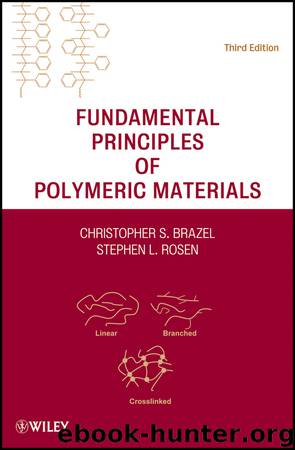Fundamental Principles of Polymeric Materials by Brazel Christopher S.; Rosen Stephen L.; & Stephen L. Rosen

Author:Brazel, Christopher S.; Rosen, Stephen L.; & Stephen L. Rosen
Language: eng
Format: epub
Publisher: Wiley
Published: 2012-04-24T16:00:00+00:00
10.8 Grafted Polymer Surfaces
Grafting a polymer onto a surface is a great way to change the surface properties of a material. This can be done to improve the compatibility between layers in a composite material, to reduce surface fouling, or to improve biocompatibility (among many potential applications). Because living polymerizations can be used for good control of polymer properties, they are often used in graft polymerizations.
The grafting method normally follows one of two patterns (Figure 10.5): grafting to or grafting from. In the first method, oligomers or polymers are pre made (and can easily be characterized for molecular weight and polydispersity) and attached to a surface through any number of chemistries (several condensation reactions can be used here). In grafting from method, the surface must be activated (i.e., form a free-radical or growing living polymer complex) through which monomer can add. In this second technique, the grafts are more difficult to analyze, since the molecular weight and polydispersity cannot be determined without destroying the surface (or at least removing the grafts). Although this drawback may seem to favor grafting to techniques, a balancing disadvantage of the grafting to technique is that the large oligomers or polymers may have significant steric hindrances or diffusive resistance in reaching the surface for binding. This results in a surface that has a lower graft coverage (graft density). Grafting techniques are discussed further by Bhattarcharya and Misra [25].
Figure 10.5 Depiction of methods to form a surface grafted with polymers. (a) Grafting from a surface by growing a polymer chain from surface functional groups (F). (b) Grafting to a surface by attaching a premade polymer to functional groups (F) on the surface.
Download
This site does not store any files on its server. We only index and link to content provided by other sites. Please contact the content providers to delete copyright contents if any and email us, we'll remove relevant links or contents immediately.
Whiskies Galore by Ian Buxton(40333)
Introduction to Aircraft Design (Cambridge Aerospace Series) by John P. Fielding(32338)
Small Unmanned Fixed-wing Aircraft Design by Andrew J. Keane Andras Sobester James P. Scanlan & András Sóbester & James P. Scanlan(32141)
Craft Beer for the Homebrewer by Michael Agnew(17447)
Turbulence by E. J. Noyes(7040)
The Complete Stick Figure Physics Tutorials by Allen Sarah(6639)
Kaplan MCAT General Chemistry Review by Kaplan(6054)
The Thirst by Nesbo Jo(5786)
Bad Blood by John Carreyrou(5770)
Learning SQL by Alan Beaulieu(5412)
Weapons of Math Destruction by Cathy O'Neil(5038)
Man-made Catastrophes and Risk Information Concealment by Dmitry Chernov & Didier Sornette(4738)
iGen by Jean M. Twenge(4702)
Digital Minimalism by Cal Newport;(4545)
Life 3.0: Being Human in the Age of Artificial Intelligence by Tegmark Max(4509)
Audition by Ryu Murakami(4099)
1,001 ASVAB Practice Questions For Dummies by Powers Rod(4039)
Electronic Devices & Circuits by Jacob Millman & Christos C. Halkias(4029)
Pale Blue Dot by Carl Sagan(4001)
